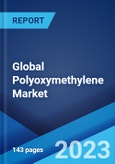The global polyoxymethylene market size reached US$ 3.3 Billion in 2022. Looking forward, the market is expected to reach US$ 4.3 Billion by 2028, exhibiting a growth rate (CAGR) of 4.51% during 2022-2028.
Polyoxymethylene (POM), or polyacetal, is a semi-crystalline engineering thermoplastic used for manufacturing components with enhanced precision, stability and sliding properties. It is widely used as a metal substitute and produced through the process of ring-opening polymerization of formaldehyde and is supplied in the form of pellets. POM is commonly available in homopolymer and copolymer variants that are utilized to manufacture mechanical gears, fasteners, bearings and medical devices, including dialysis machines, inhalers and pharmaceutical closures. POM exhibits various advantageous properties, such as wide operating temperature range, minimal friction, high dimensional stability and heat, chemical and wear resistance. As a result, it finds extensive applications across various industries, including electronic, automotive and electrical.
Polyoxymethylene (POM), or polyacetal, is a semi-crystalline engineering thermoplastic used for manufacturing components with enhanced precision, stability and sliding properties. It is widely used as a metal substitute and produced through the process of ring-opening polymerization of formaldehyde and is supplied in the form of pellets. POM is commonly available in homopolymer and copolymer variants that are utilized to manufacture mechanical gears, fasteners, bearings and medical devices, including dialysis machines, inhalers and pharmaceutical closures. POM exhibits various advantageous properties, such as wide operating temperature range, minimal friction, high dimensional stability and heat, chemical and wear resistance. As a result, it finds extensive applications across various industries, including electronic, automotive and electrical.
Polyoxymethylene Market Trends
The increasing demand for medical-grade POM for the manufacturing of healthcare devices is one of the key factors driving the growth of the market. POM is also widely used for the production of pen caps, outer needle caps, inner needle caps and dosage knobs of the insulin pens due to low moisture absorption, high sterility and impact resistant properties. It is also utilized for manufacturing pacemakers, artificial valves and joint reconstruction devices. Moreover, the widespread product adoption in the electronics industry is providing a thrust to the market growth. POM is utilized in electric housing, circuit boards, switches, enclosures, wiring components and cooling systems. In line with this, the increasing adoption of POM for the manufacturing of various plumbing components, such as pump impellors, fittings, appliance casings, valve stems and jug kettles, is also contributing to the market growth. Other factors, including the rising demand for effective food packaging solutions, along with the utilization of POM for automotive steering wheels, locks, door handles and headrests, are acting as other growth-inducing factors.Key Market Segmentation
This research provides an analysis of the key trends in each sub-segment of the global polyoxymethylene market report, along with forecasts at the global, regional and country level from 2023-2028. The report has categorized the market based on type, process, grade and end user.Breakup by Type:
- Homopolymer POM
- Copolymer POM
Breakup by Process:
- Injection Molding
- Extrusion Molding
Breakup by Grade:
- Standard
- Reinforced
- Impact Modified
- Recycled
- UV Stabilized
Breakup by End User:
- Electrical and Electronics
- Automotive and Transportation
- Medical
- Consumer Goods and Appliances
- Construction
Breakup by Region:
- North America
- United States
- Canada
- Asia-Pacific
- China
- Japan
- India
- South Korea
- Australia
- Indonesia
- Europe
- Germany
- France
- United Kingdom
- Italy
- Spain
- Russia
- Latin America
- Brazil
- Mexico
- Middle East and Africa
Competitive Landscape
The competitive landscape of the industry has also been examined along with the profiles of the key players being Asahi Kasei Corporation, BASF SE, Celanese Corporation, Daicel Corporation, DuPont de Nemours Inc., Kolon Plastic Inc., LG Chem Ltd., LyondellBasell Industries N.V., Mitsubishi Engineering-Plastics Corporation, RTP Company (Miller Waste Mills Inc.), Saudi Basic Industries Corporation (Saudi Arabian Oil Co.) and Westlake Plastics Company.Key Questions Answered in This Report:
- How has the global polyoxymethylene market performed so far and how will it perform in the coming years?
- What has been the impact of COVID-19 on the global polyoxymethylene market?
- What are the key regional markets?
- What is the breakup of the market based on the type?
- What is the breakup of the market based on the process?
- What is the breakup of the market based on the grade?
- What is the breakup of the market based on the end user?
- What are the various stages in the value chain of the industry?
- What are the key driving factors and challenges in the industry?
- What is the structure of the global polyoxymethylene market and who are the key players?
- What is the degree of competition in the industry?
Table of Contents
1 Preface3 Executive Summary12 Value Chain Analysis14 Price Analysis
2 Scope and Methodology
4 Introduction
5 Global Polyoxymethylene Market
6 Market Breakup by Type
7 Market Breakup by Process
8 Market Breakup by Grade
9 Market Breakup by End User
10 Market Breakup by Region
11 SWOT Analysis
13 Porters Five Forces Analysis
15 Competitive Landscape
Companies Mentioned
- Asahi Kasei Corporation
- BASF SE
- Celanese Corporation
- Daicel Corporation
- DuPont de Nemours Inc.
- Kolon Plastic Inc.
- LG Chem Ltd.
- LyondellBasell Industries N.V.
- Mitsubishi Engineering-Plastics Corporation
- RTP Company (Miller Waste Mills Inc.)
- Saudi Basic Industries Corporation (Saudi Arabian Oil Co.)
- Westlake Plastics Company
Methodology

LOADING...
Table Information
| Report Attribute | Details |
|---|---|
| No. of Pages | 143 |
| Published | November 2023 |
| Forecast Period | 2022 - 2028 |
| Estimated Market Value ( USD | $ 3.3 Billion |
| Forecasted Market Value ( USD | $ 4.3 Billion |
| Compound Annual Growth Rate | 4.5% |
| Regions Covered | Global |
| No. of Companies Mentioned | 12 |









